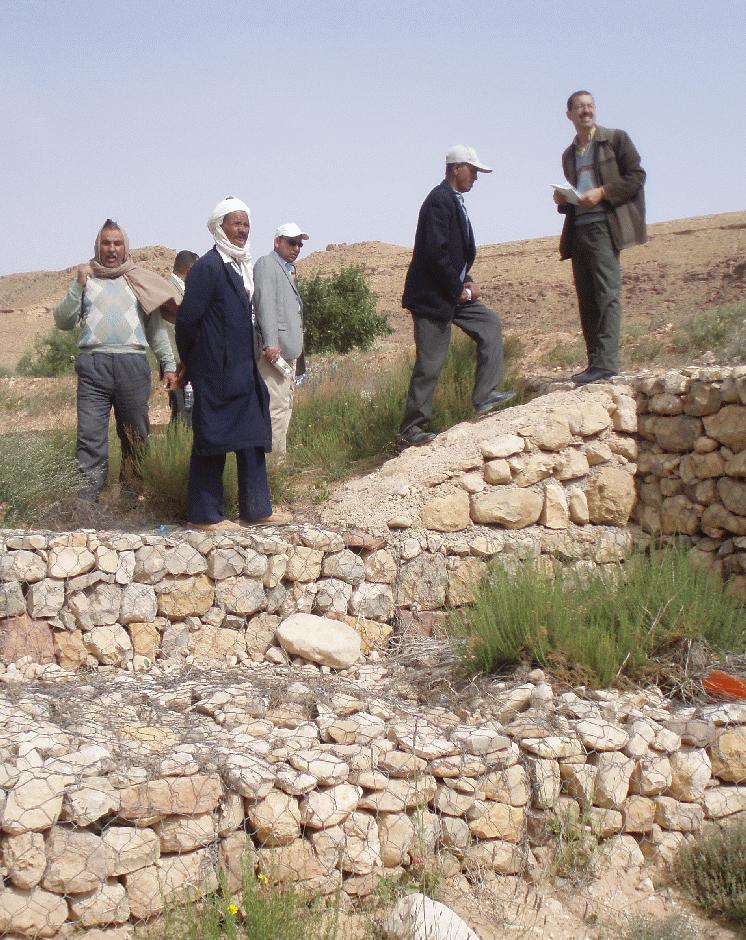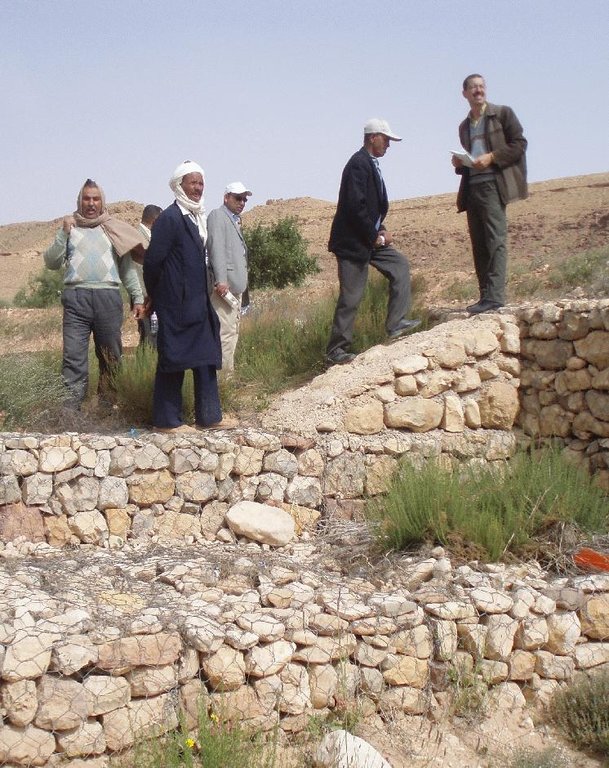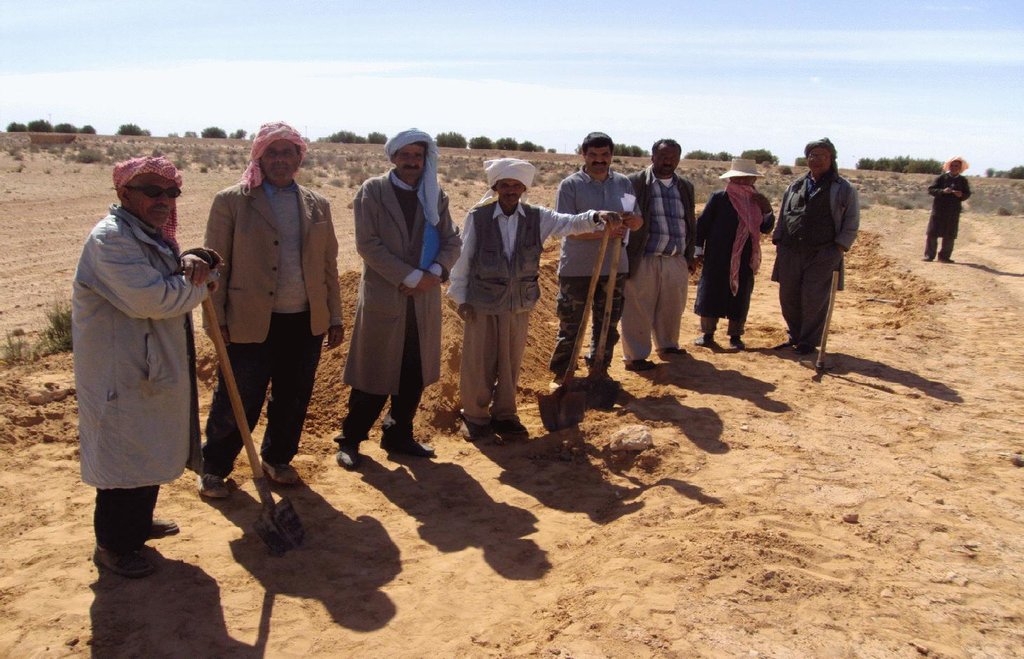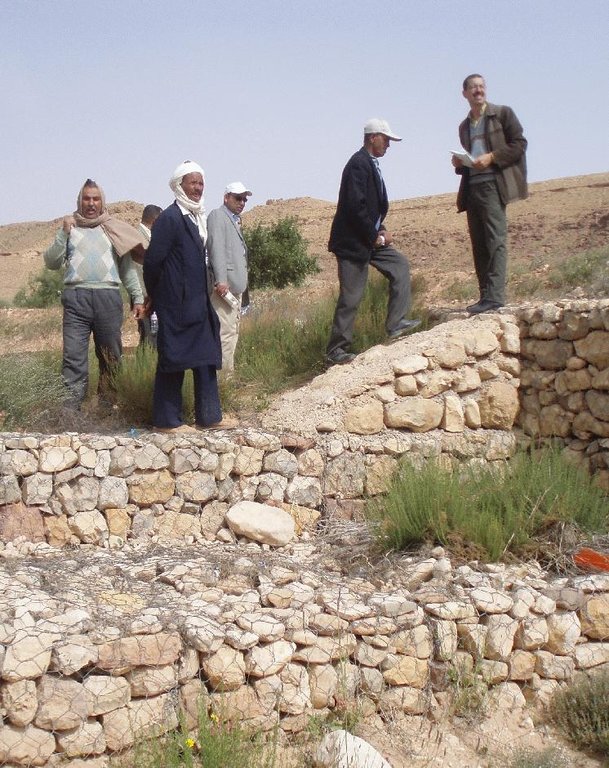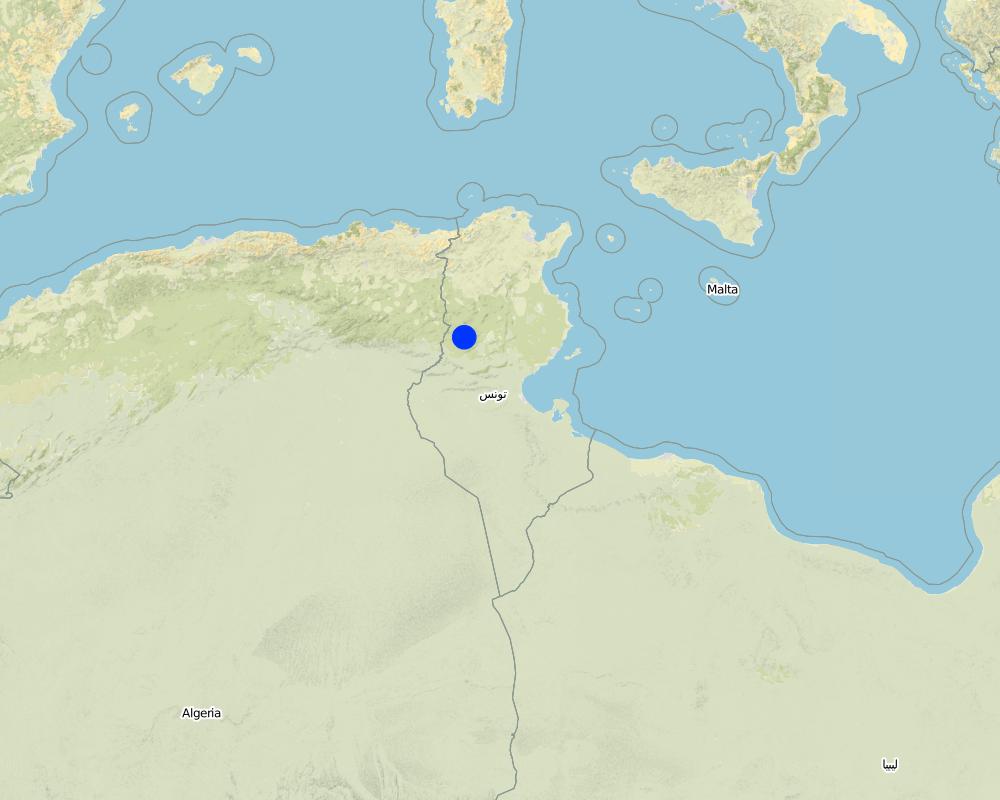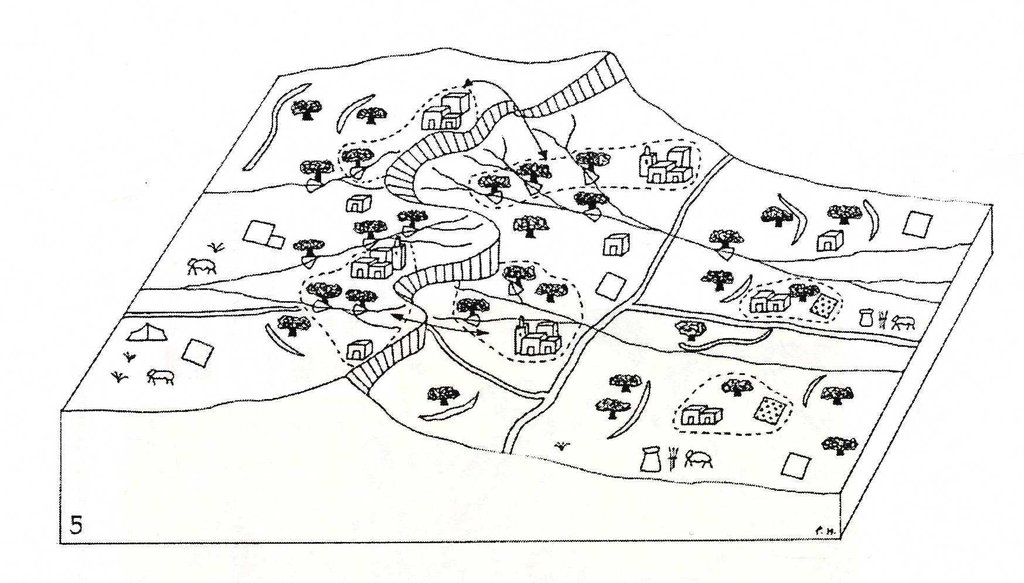Dryland watershed management approach [Tunisia]
- Creation:
- Update:
- Compiler: Naceur Mahdi
- Editor: –
- Reviewers: Fabian Ottiger, Deborah Niggli
approaches_2422 - Tunisia
View sections
Expand all Collapse all1. General information
1.2 Contact details of resource persons and institutions involved in the assessment and documentation of the Approach
SLM specialist:
SLM specialist:
Sghaier Mongi
sghaier.mon@gmail.com
Institut des Régions Arides
4119 Medenine
Tunisia
Name of project which facilitated the documentation/ evaluation of the Approach (if relevant)
DESIRE (EU-DES!RE)Name of the institution(s) which facilitated the documentation/ evaluation of the Approach (if relevant)
Institut des Régions Arides de Médenine (Institut des Régions Arides de Médenine) - Tunisia1.3 Conditions regarding the use of data documented through WOCAT
The compiler and key resource person(s) accept the conditions regarding the use of data documented through WOCAT:
Yes
1.4 Reference(s) to Questionnaire(s) on SLM Technologies
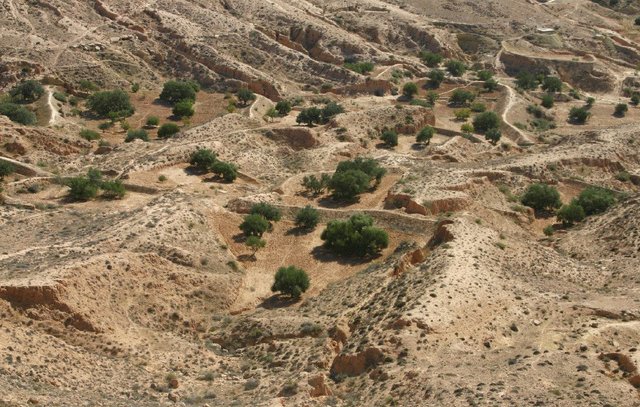
Jessour [Tunisia]
Jessour is an ancient runoff water harvesting technique widely practiced in the arid highlands
- Compiler: Mongi Ben Zaied
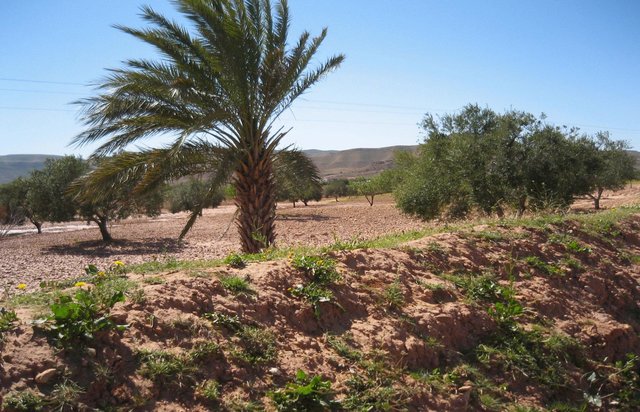
Tabia [Tunisia]
The tabia earthen dyke is a water harvesting technique used in the foothill and piedmont areas.
- Compiler: Mongi Ben Zaied
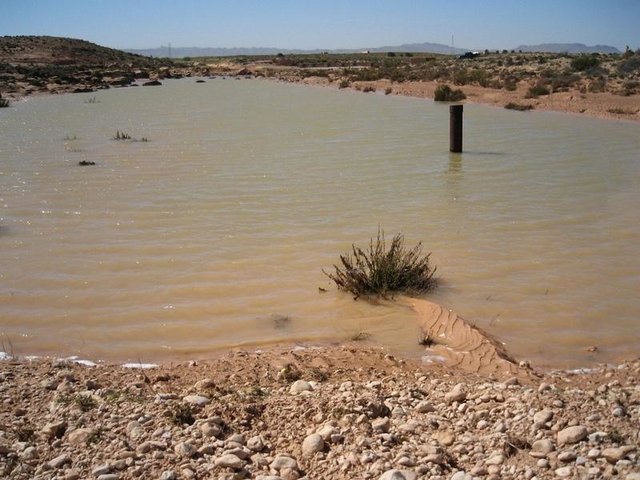
Recharge well [Tunisia]
A recharge well comprises a drilled hole, up to 30-40 m deep that reaches the water table, and a surrounding filter used to allow the direct injection of floodwater into the aquifer.
- Compiler: Mongi Ben Zaied
2. Description of the SLM Approach
2.1 Short description of the Approach
Integrated land and water management approach, including vegetative, management, and agronomic measure
2.2 Detailed description of the Approach
Detailed description of the Approach:
Aims / objectives: The overall purpose of the approach is to prevent soil and water loss by combined measures and to provide a better environment. Soil and water conservation (SWC) technologies, based on harvesting area of surface water and underground water, are implemented to conserve soil and water and to improve the production and the biodiversity.
Methods: This approach is designed for the exploitation of water runoff for agricultural development, particularly for fruit trees cropping (mainly olives).This can be achieved through erosion reduction and aquifer recharge via runoff water infiltration into the terraces, slope angle and length reduction, runoff retaining, infiltration increase and soil loss reduction. The system is based on various runoff water harvesting systems, as jessour, tabias. It is marked by fruit tree development, notably olives. On the terraces, the fruit trees are arranged in inter-rows with the three main species encountered in the study areas. Generally, olive trees are planted, with in between rows almonds and/ or fig trees. SWC technologies play an importance role in arid zones. Since the 1970s, the Tunisian state has encouraged the local population to conserve water and soil in arid zone. Successive programmes and strategies of water and soil conservation have been developed and were implemented in all three natural regions of Tunisia (North, Centre and South).These techniques can be implemented by farmer with governmental subsidies or by government intervention in the projects and programmes of water and soil conservation. During the last decade, the Tunisian government implemented the first national strategy for soil and water conservation (1990-2000) and the second national strategy for soil and water conservation (2001-2011). These strategies mobilized important funds at national and regional levels. About 672.5 ha of SWC technologies were built and about 550 ha of SWC technologies are planned for the second national strategy.
Stages of implementation: 1) Assessment of the current natural resources and socio-economic conditions; 2) Proposition of actions at local and regional level; 3) Aggregation and coherence at the national level; 4) implementation of national action plan at local and regional level.
Role of stakeholders: Different levels of intervention are observed from the individual farm, through the community level, the extension / advisory system, the regional or national administration, or the policy level, to the international framework. The participative approach is usually applied in the construction of SWC technologies.
2.3 Photos of the Approach
2.5 Country/ region/ locations where the Approach has been applied
Country:
Tunisia
Region/ State/ Province:
south-east of tunisia
Further specification of location:
Oum Zessar Watershed
Map
×2.6 Dates of initiation and termination of the Approach
Indicate year of initiation:
1960
2.7 Type of Approach
- recent local initiative/ innovative
2.8 Main aims/ objectives of the Approach
The Approach focused on SLM only (production, soil fertility, biodiversity, employement oppourtunities, food self-sufficiency, fixing population and stop farming exodus)
The objectives of the approach are to control soil and water loss to reduce floods and enhance fertility, to enhance rainfed agriculture productivity, to improve the livelihoods of farmers, to contribute to the production increase among farmers and pastoralists, to recharge the groundwater and to extend the area of cropland.
The SLM Approach addressed the following problems: The problems originate in the scarcity of water which is leading to conflicts over resource use between farmers. Oversized techniques leading to prevention of runoff from upstream to downstream reduce agricultural production and therefore the farm income, which causes a lack of cash to invest in SLM. In some cases irreversible land degradation is the result. The problems are mainly related to the lack of technical knowledge, the high costs of investment and the lack of tangible and assessable impacts of SWC activities, technically or socially.
2.9 Conditions enabling or hindering implementation of the Technology/ Technologies applied under the Approach
availability/ access to financial resources and services
- hindering
High cost investment
Treatment through the SLM Approach: Public projects (National strategy of SWC), subsidies
institutional setting
- hindering
Land fragmentation, complexity of land tenure,
Treatment through the SLM Approach: Users organisation, participation
legal framework (land tenure, land and water use rights)
- enabling
The existing land ownership, land use rights / water rights greatly helped the approach implementation: The approach helped in the privatization of the land and has therefore greatly reduced the land/water use rights problems. This in turn has rendered the local interventions much more efficient.
knowledge about SLM, access to technical support
- hindering
Designing parameters
Treatment through the SLM Approach: Training , Ehancing SWC specialists guidance
3. Participation and roles of stakeholders involved
3.1 Stakeholders involved in the Approach and their roles
- local land users/ local communities
Working land users were mainly men (Men are the main force for field work.)
Special attention has been paid to make women participate in the approach. Nevertheless, men have much more technical knowledge and skills than women because if SWC technologies have to be constructed by manual labour, men can achieve more. Poor and old people are especially involved through their participation in the special programme against unemployment in rural area. Some unemployed young people may benefit from agricultural development programmes.
- SLM specialists/ agricultural advisers
The choice on the technology to use is made primarily by the technical specialists based on the prevalent type of erosion on each farm and farmers preference.
- national government (planners, decision-makers)
- international organization
If several stakeholders were involved, indicate lead agency:
National and state specialists together with land users.
3.2 Involvement of local land users/ local communities in the different phases of the Approach
| Involvement of local land users/ local communities | Specify who was involved and describe activities | |
|---|---|---|
| initiation/ motivation | interactive | Farmers and local population are very familiar with traditional SWC applied. Therefore the receptiveness to these techniques is very high. There is state encouragement through subsidies. |
| planning | interactive | Workshops/seminars; After a programme is granted, the implementing agency and local communities work together. |
| implementation | external support | Responsibilities are divided into major steps; In practice, local communities are the major part to manage and carry out. |
| monitoring/ evaluation | interactive | Participative evaluation; Interviews/questionnaires. |
| Research | interactive | It can give some suggestions or questionnaires. |
3.3 Flow chart (if available)
Description:
The treatment of the catchment starts from the upstream and continues to piedmont areas, and ends in the downstream section of the catchment. Attention should be given to ensure sufficient water allocation to all the sections of the catchment as well as to the different users (rainfed agriculture and rangelands, irrigated areas, drinking water, industry and tourism).
Author:
Patricia Home
3.4 Decision-making on the selection of SLM Technology/ Technologies
Specify who decided on the selection of the Technology/ Technologies to be implemented:
- mainly land users, supported by SLM specialists
Explain:
consultative,explain
Decisions on the method of implementing the SLM Technology were made by mainly by SLM specialists with consultation of land users. Decisions are made by politicians/SWC specialists; land users are consulted in the planning phase (experienced farmers may be involved initially).
4. Technical support, capacity building, and knowledge management
4.1 Capacity building/ training
Was training provided to land users/ other stakeholders?
Yes
Specify who was trained:
- land users
- field staff/ advisers
If relevant, specify gender, age, status, ethnicity, etc.
The capacity building programme and activities have benefited farmers representing the diversity of land users (women and men); representatives of NGO; local and external stakeholders, engineers and technicians responsible of the services of agriculture and forest.
Form of training:
- farmer-to-farmer
- demonstration areas
- public meetings
Subjects covered:
Training focused on teaching them how to design and build SWC technologies, how to implement these technologies and about the participatory approach.
4.2 Advisory service
Do land users have access to an advisory service?
Yes
Specify whether advisory service is provided:
- at permanent centres
Describe/ comments:
Name of method used for advisory service: Integrated watershed management; Key elements: Training and demonstration open days, Demonstration plots implemented in private farms, Target farmers groups are visited by specialist to help and advise them.; 1) Advisory service was carried out through: government's existing extension system. Extension staff: mainly government employees 3) Target groups for extension: planners; Activities: training
Advisory service is quite adequate to ensure the continuation of land conservation activities; The extension system is adequate to ensure continuation of activities. At each governorate level, there is a SWC division which is in charge of SWC activities, including its extension.extension
4.3 Institution strengthening (organizational development)
Have institutions been established or strengthened through the Approach?
- yes, moderately
Specify the level(s) at which institutions have been strengthened or established:
- local
Specify type of support:
- financial
Give further details:
support with financial resources, capacity building, training, institutional support. The financial schema is made of three main components: self-financing from farmers and beneficiaries, subsidies from the government and credit from bank.
4.4 Monitoring and evaluation
Is monitoring and evaluation part of the Approach?
Yes
Comments:
economic / production aspects were ad hoc monitored by project staff through measurements; indicators: investigation/ of yield, income of land users, rainfed productivity
socio-cultural aspects were ad hoc monitored by project staff through observations; indicators: Investigation of land users perceptions of cultural change
bio-physical aspects were ad hoc monitored by project staff through measurements; indicators: Indicators are runoff loss, sediment load, soil moisture
area treated aspects were ad hoc monitored by government through measurements; indicators: Impact assessment
management of Approach aspects were None monitored by government through measurements; indicators: None
There were few changes in the Approach as a result of monitoring and evaluation: for example at the institutional level.
4.5 Research
Was research part of the Approach?
Yes
Specify topics:
- technology
- approaches
Give further details and indicate who did the research:
Land users have been involved. SWC technologies construction is based on scientific design, according to local conditions.
Research was carried out both on station and on-farm
5. Financing and external material support
5.1 Annual budget for the SLM component of the Approach
If precise annual budget is not known, indicate range:
- 10,000-100,000
Comments (e.g. main sources of funding/ major donors):
Approach costs were met by the following donors: local community / land user(s): 20.0%; national non-government: 5.0%; government: 55.0%; international: 20.0%
5.2 Financial/ material support provided to land users
Did land users receive financial/ material support for implementing the Technology/ Technologies?
Yes
5.3 Subsidies for specific inputs (including labour)
- equipment
| Specify which inputs were subsidised | To which extent | Specify subsidies |
|---|---|---|
| machinery | partly financed | |
- construction
| Specify which inputs were subsidised | To which extent | Specify subsidies |
|---|---|---|
| stone | partly financed | |
If labour by land users was a substantial input, was it:
- voluntary
Comments:
Voluntary but rewarded with in-kind support by government subsidies
5.4 Credit
Was credit provided under the Approach for SLM activities?
Yes
Specify conditions (interest rate, payback, etc.):
repayment conditions: Credit was promoted through agricultural banks with various interest rates, usually lower than market rates.
6. Impact analysis and concluding statements
6.1 Impacts of the Approach
Did the Approach help land users to implement and maintain SLM Technologies?
- No
- Yes, little
- Yes, moderately
- Yes, greatly
Land users can harvest water and irrigate crops in dry seasons. Meanwhile, the cropland area is enlarged.
Did the Approach empower socially and economically disadvantaged groups?
- No
- Yes, little
- Yes, moderately
- Yes, greatly
for disadvantaged women and men, there are employment opportunities and food self-sufficiency
Did the Approach improve issues of land tenure/ user rights that hindered implementation of SLM Technologies?
- No
- Yes, little
- Yes, moderately
- Yes, greatly
Did other land users / projects adopt the Approach?
- No
- Yes, little
- Yes, moderately
- Yes, greatly
Did the Approach lead to improved livelihoods / human well-being?
- No
- Yes, little
- Yes, moderately
- Yes, greatly
because of increased farm income.
Did the Approach help to alleviate poverty?
- No
- Yes, little
- Yes, moderately
- Yes, greatly
this appraoch increase farm income, food self-sufficiency and employer opportunities
6.2 Main motivation of land users to implement SLM
- increased production
increase yield; Food self-sufficiency
- increased profit(ability), improved cost-benefit-ratio
increase farm income
- payments/ subsidies
invest in SWCT
- well-being and livelihoods improvement
Employer opportunities
6.3 Sustainability of Approach activities
Can the land users sustain what has been implemented through the Approach (without external support)?
- uncertain
If no or uncertain, specify and comment:
Can given the recent escalation in payments made to land users for implementation under certain projects it seems that the costs will be too high to sustain. Currently the Ministry of Agricultural is demanding that in-depth cost-benefit analyses are carried out involving environmental, social as well as economic assessments
6.4 Strengths/ advantages of the Approach
| Strengths/ advantages/ opportunities in the land user’s view |
|---|
| Reduction of soil erosion (How to sustain/ enhance this strength: ensure the durability of the works implemented) |
| Strengths/ advantages/ opportunities in the compiler’s or other key resource person’s view |
|---|
| Improvement of livelihood (How to sustain/ enhance this strength: spreading and improvement of a more holistic SLM approach focusing on livelihoods) |
| Many people involved and trained at different levels (pyramid system) (How to sustain/ enhance this strength: participatory approach) |
| More participation and involvement of local population (How to sustain/ enhance this strength: Improve participatory approach and increase confidence between partners) |
6.5 Weaknesses/ disadvantages of the Approach and ways of overcoming them
| Weaknesses/ disadvantages/ risks in the land user’s view | How can they be overcome? |
|---|---|
| Abandonment of the works, less maintenance | Continue to support farmers and local institution and organisation. Repairing and maintaining in time. |
| Low impact on livelihood conditions | improve efficiency of SWC activities and participatory approach |
| Weaknesses/ disadvantages/ risks in the compiler’s or other key resource person’s view | How can they be overcome? |
|---|---|
| Less confidence between partners and less participation | improve dialog and communication; improve efficiency of SWC activities and participatory approach. |
| High costs: farmers depend on external support from the government; they are not willing to invest their labour without payments | New approach should give farmers loans for construction as now they use machines to do the work. In addition, search for cheaper SWC technologies and for improving the benefits. |
7. References and links
7.1 Methods/ sources of information
- field visits, field surveys
- interviews with land users
7.2 References to available publications
Title, author, year, ISBN:
Genin D., Guillaume H., Ouessar M., Ouled Belgacem A., Romagny B., Sghaier M., Taamallah H. (Eds) 2006. Entre la désertification et le développement : la Jeffara tunisienne. CERES, Tunis; de Graaff J. & Ouessar M. (Eds.) 2002Water harvesting in Mediterranean zones: an impact assessment and economic evaluation.
Available from where? Costs?
TRMP paper n° 40, Wageningen University, The Netherlands
Title, author, year, ISBN:
Water harvesting in Mediterranean zones: an impact assessment and economic evaluation.
Available from where? Costs?
TRMP paper n° 40, Wageningen University, The Netherlands
Links and modules
Expand all Collapse allLinks

Jessour [Tunisia]
Jessour is an ancient runoff water harvesting technique widely practiced in the arid highlands
- Compiler: Mongi Ben Zaied

Tabia [Tunisia]
The tabia earthen dyke is a water harvesting technique used in the foothill and piedmont areas.
- Compiler: Mongi Ben Zaied

Recharge well [Tunisia]
A recharge well comprises a drilled hole, up to 30-40 m deep that reaches the water table, and a surrounding filter used to allow the direct injection of floodwater into the aquifer.
- Compiler: Mongi Ben Zaied
Modules
No modules


